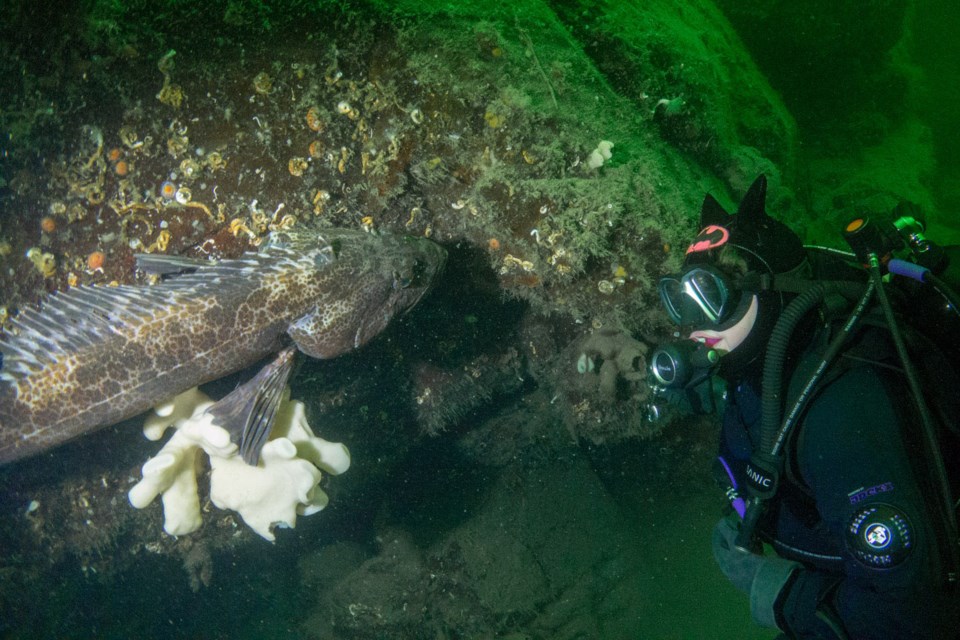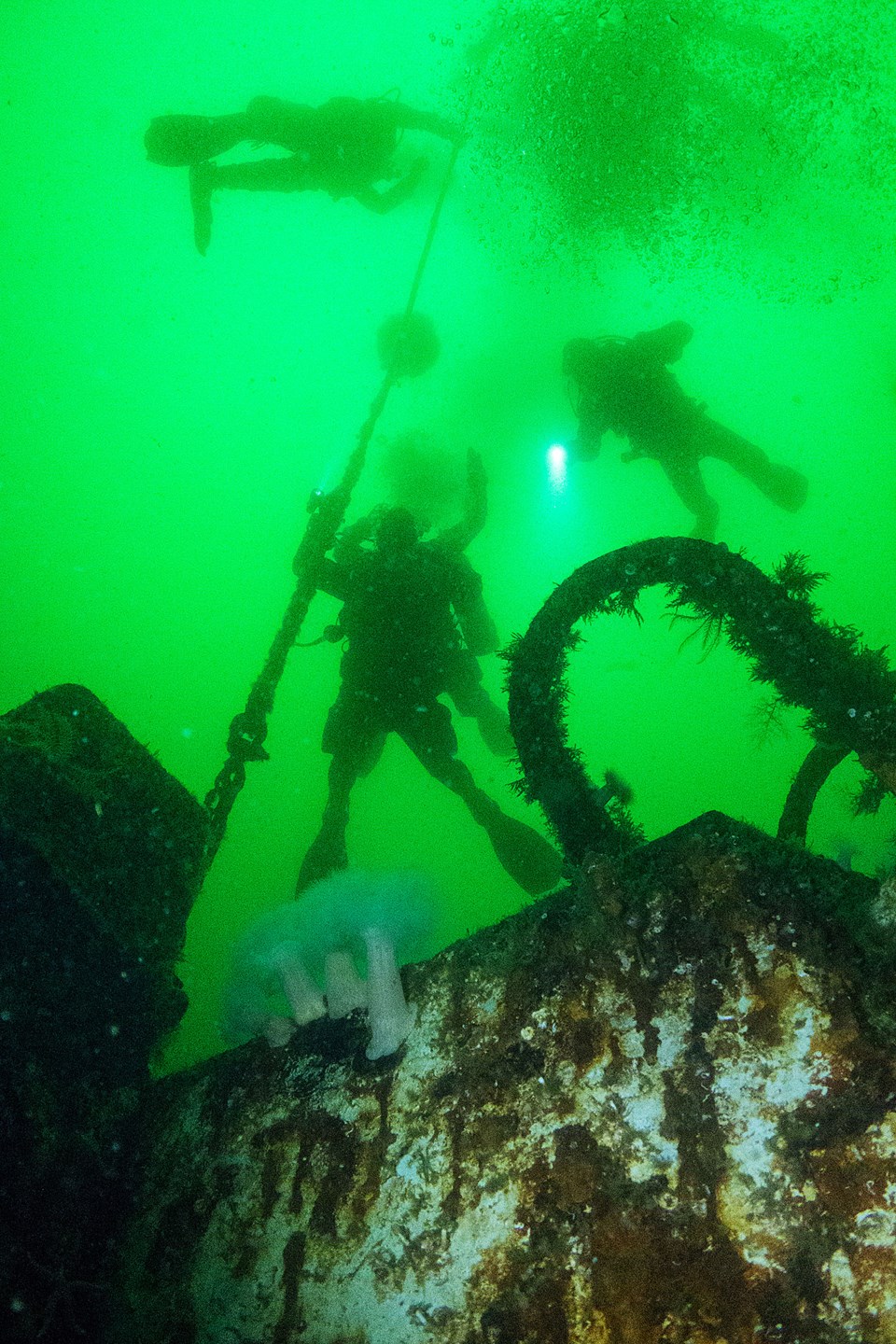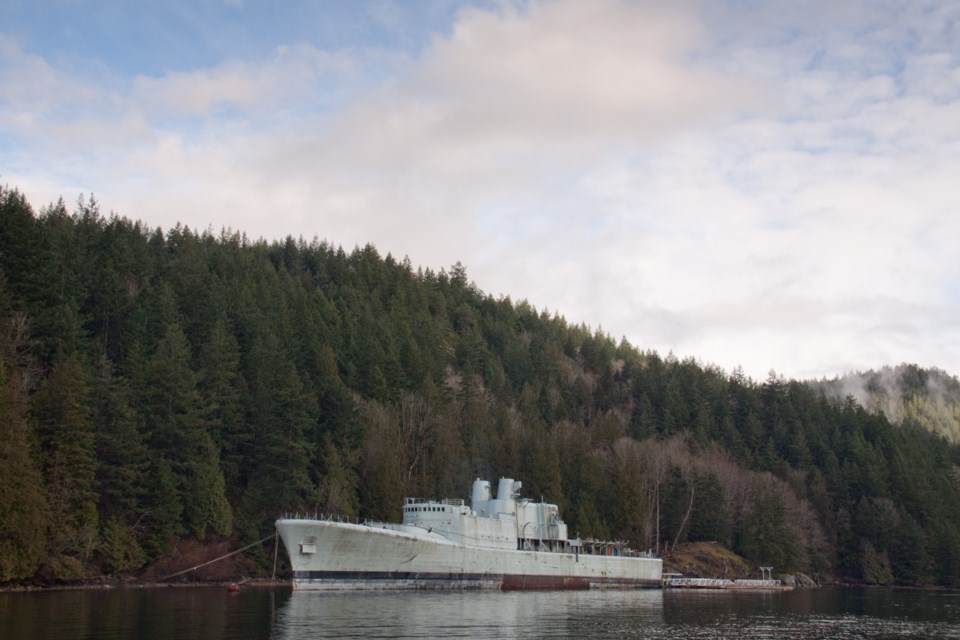The HMCS Annapolis didn’t see action during her three decades patrolling the seas as part of the Royal Canadian Navy. However, the 110-metre warship may soon see a very different kind of action as a new scuba diving destination in Howe Sound.
The Courier visited the ship on June 28 as part of UNESCO’s inaugural Dive for Peace Day, a global initiative meant to mark the anniversary of the assassination of Austrian archduke Franz Ferdinand and his wife Sophie 100 years ago that triggered the beginning of the First World War.
Since Vancouver waters don’t offer much in the way of WWI memorabilia, a dive trip led by Sea Dragon Charters instead offered a tour of the Cold War-era battleship — currently afloat in Port Graves on Gambier Island — after first exploring some steep undersea cliffs beneath the remains of North Shore gun ramparts that once guarded the First Narrows from potential enemy invasion during the Second World War.

The Annapolis was launched in 1963 and decommissioned in 1996. She then sat rusting at CFB Esquimalt on Vancouver Island before being purchased by the Artificial Reef Society of B.C. (ARSBC) in 2009 for an undisclosed sum. The non-profit group has eight sunken military vessels under its belt, not to mention a Boeing 737 near Chemainus, but this would be the first ship scuttled a short distance from a major tourist destination.
“It is designed as an asset that goes to the province and it’s all about dive-site eco-tourism,” said ARSBC president Howie Robins. “This is one of the nice things about having the ship so close to Vancouver and about 20 minutes from Horseshoe Bay, it really provides us with a living library to see the kinds of biological changes that can occur without having to take the ferry somewhere.”
The late, great aquatic explorer Jacques Cousteau once described British Columbia as offering “the best temperate water diving in the world and second only to the Red Sea,” and the ARSBC hopes to see the Annapolis, despite the chilly water, become a major draw for international divers more accustomed to tropical diving. Shipwreck diving also typically involves highly specialized training, and wrecks are often found at greater depths than many recreational divers are comfortable with.
If all goes according to plan, the Annapolis will be sunk in relatively shallow water in Halkett Bay Marine Park and, because the ship was equipped to transport and service massive Sea King helicopters, it would offer a lot of open-space options for exploration that wouldn’t require swimming through dangerous narrow passages.
“The maximum depth will be about 105 feet at high tide in an area that is reasonably consistent at depth because we are basically putting the ship in a strategic area on a ledge,” said Robins. “Most of the diving will be between 50 and 90 feet and you’ll be able to see at least 85 to 90 per cent of the ship.”
The practice of creating artificial reefs has been around for centuries and they are built for reasons as diverse as blocking waves or boat traffic to creating better fishing spots.
The process of how — or even if — a man-made leviathan like the Annapolis eventually becomes one is determined by variables such as depth, currents and the make-up of the sea floor. Robins says the Halkett Bay sea bottom would be an ideal setting for an artificial reef because it’s previously been damaged from the island’s log-booming days due to bark and other fibrous materials having smothered marine life on the ocean floor after sinking.
Most artificial reefs attract aquatic life in foreseeable steps. First, when currents encounter a vertical structure like a sunken vessel, it can create a plankton-rich upwelling that provides a good feeding spot for smaller fish, which in turns draws larger predators.
Eventually, the metal exterior becomes encrusted with algae, anemones, corals and sponges, sprouting aquatic life like some sort of submersed, supersized Chia Pet and eventually becomes home to crabs, wolf eels, octopus, ling cod, rock fish and more.

“The nice thing about wrecks this size is that you can keep going back and never see the same thing twice,” said scuba instructor Trisha Stovel “I’ve been to the Cape Breton three times over the years and every time has been completely different.” (The ARSBC sank the 135-metre HMCS Cape Breton off the coast of Nanaimo in 2001.)
The dream of sinking the battleship, originally scheduled for 2010, has been a hard-fought battle. Robins said that a lack of shipyard space due to the 2010 Olympics meant that dozens of volunteers had to make their way to Gambier Island to strip the vessel of hazardous materials.
The beginning of the project also coincided with the 2008 stock market crash, and the value of scrap metal — the sink-and-swim project’s main source of funding — quickly bottomed out. There was also objection from a group called Save Halkett Bay, a group of island residents who oppose sinking the ship in their backyard due to environmental and increased traffic concerns.
Last but not least, the ship is also still subject of a lawsuit from the owner of WR Marine Services, who claims he is still owed nearly $100,000 for stripping and mooring the vessel.
Although Robins said he is hoping to send the Annapolis to a watery grave by the end of this summer, a date has yet to be finalized and his organization is still waiting for final approval from Environment Canada.
“It is premature to set a date until we have all our ducks in a row with the regulatory authorities. We’re still working through our government permitting process but there are no issues there and this is just a matter of course.”
afleming@vancourier.com



